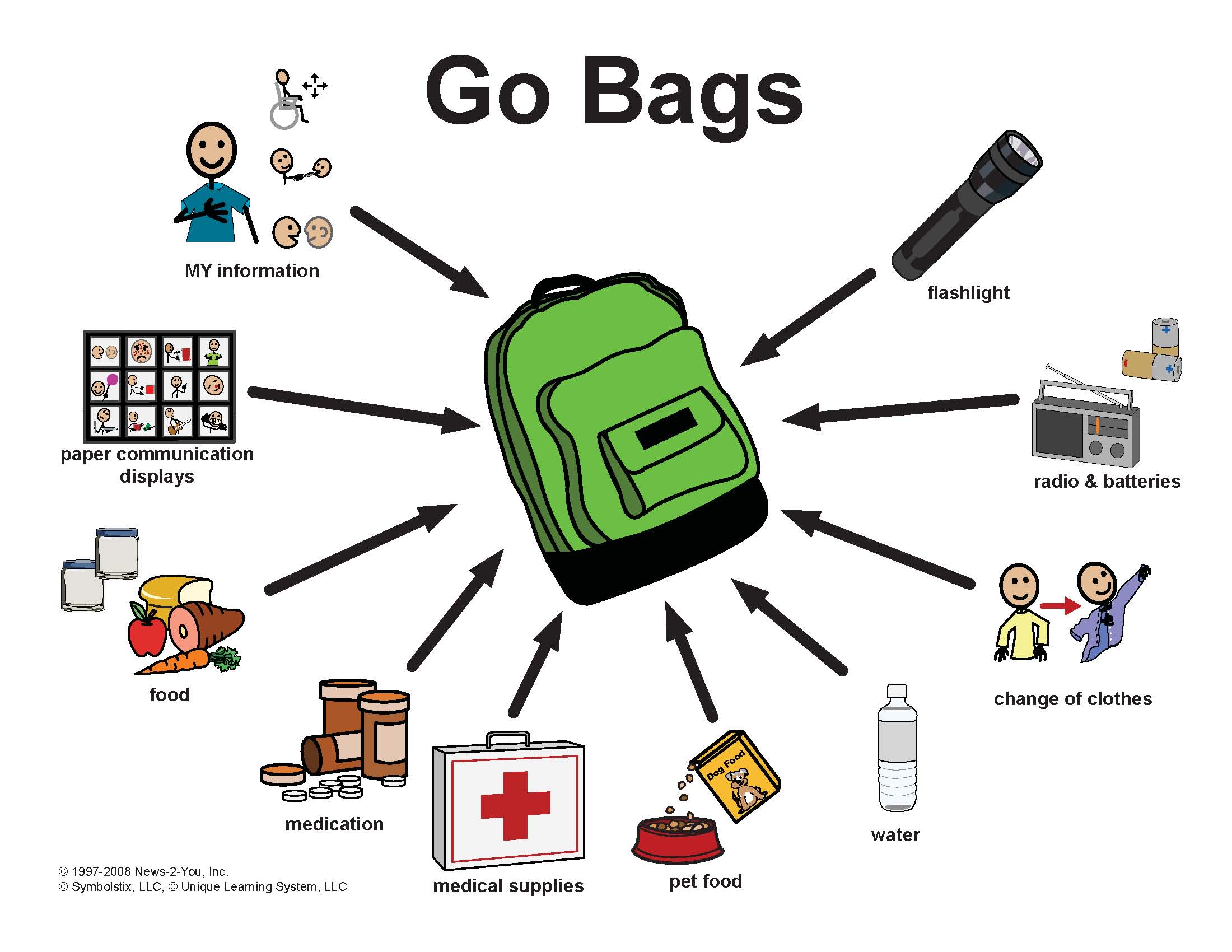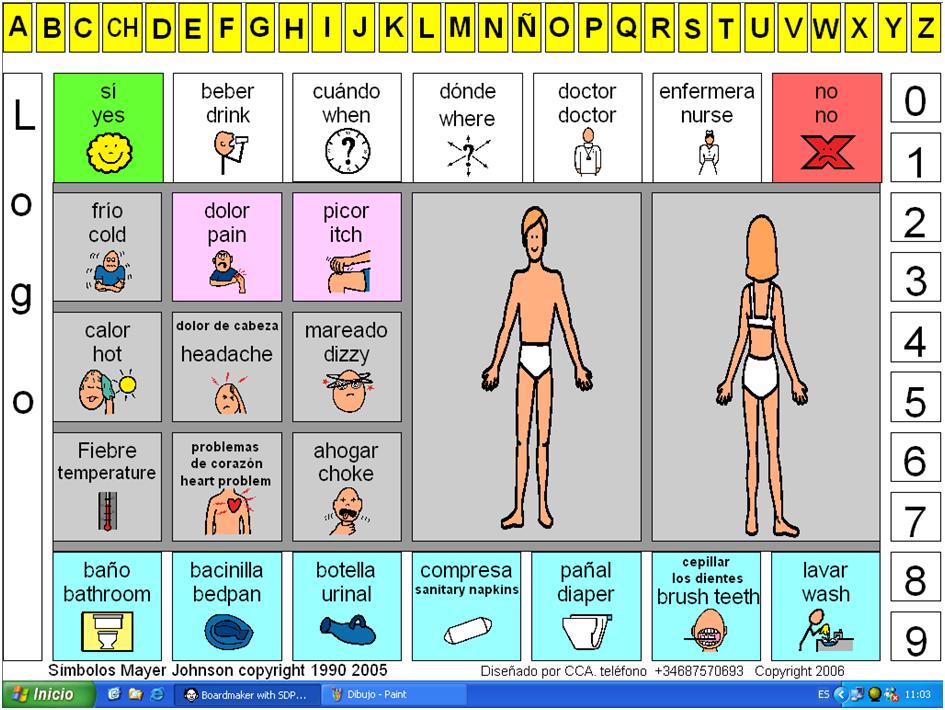People with Limited Speech and Those Who Care About Them:
Taking Responsibility for Your Safety
Are you prepared for an emergency? Are the people you care about ready?
Is your “Go Bag” packed? Do you ALWAYS carry a paper communication display with you?
Disasters happen everywhere. Sometimes there is a warning, but not always. Types of disasters include floods, tornados, tsunamis, earthquakes, extreme temperatures, chemical leaks, terrorist attacks on people, contamination of the water supply and so on.
In emergency/disaster situations, there are no guarantees. BE PREPARED!
Download a PDF of the CHECKLIST and information on this page
|
Taking Responsibility for Your Safety: People with Limited Speech and Those Who Care About Them |
|
1. Do you have a support team? Does everyone know what to do? |
|
7. If you think, “Never mind….this won’t ever happen to me?” THINK AGAIN. Emergencies can (and do) happen to anyone. Be PREPARED, not sorry. |
1. Support Team
EVERYONE needs a support team. Most rescues are done by friends and neighbors.
Your chances of getting the help you need may depend on your support team.
- Train as many people as you can (at least three). Each team member needs to know how to help.
- Put the plan in writing and practice with your team. Update your plan quarterly.
- Include information about how you will be evacuated, sheltered and how you will communicate in your plan.
- Prepare Your Go Bags so you will have all necessary items available.
- ALWAYS HAVE A BACKUP PLAN. Not everyone may be able to get to you.
- If you cannot take advantage of TV, radio alerts because of hearing or vision problems, plan how you will be alerted.
Resources: Go to http://www.cdihp.org/products.html#evac_guide to access the Emergency Evacuation Preparedness Guide. Accessed on 7/15/08.
2. An Evacuation Plan
You need to make arrangements in advance. First, identify your support team (see #1 above). They need to be informed and updated quarterly.
- Put your plans in writing. Make sure each member of your support team has a copy.
- Do not assume you will have electric power. Plan accordingly.
- Practice the plan. Do a trial run of evacuation procedures to work out the quirks. Then practice regularly.
- You have the right to bring a service animal, your communication tools and accessories (switches, battery pack, mount) with you. You also have the right to bring someone who understands your communication/basic needs with you if you are evacuated.
- Plan for elevators being 'out' if you live/work in a multi story building.
Resources: Go to http://www.cdihp.org/products.html#evac_guide to access the Emergency Evacuation Preparedness Guide. Accessed on 7/15/08.
3. Your “Go Bag”
You need to have a “Go Bag” packed and located where you can get it quickly in case you need to leave your home/workplace. Note: You may need more than one “Go Bag.”
a. You will NOT have time to “throw things together” or quickly access everything you will need in an emergency. You MUST prepare in advance.
b. Don’t forget to include specific equipment, such as feeding equipment, batteries, switches, chargers, a laminated communication display so you can access pertinent vocabulary.
c. Make sure you label all items because things get lost easily in shelters.
d. Consider making a small manual with photos to provide instructions about how you need to be lifted and seated, how you sleep and eat. Be sure to include information about how you communicate, how to maintain your equipment, etc.
Resources: Search Google for "Go Bags" (e.g., http://www.redcrossstore.org/shopper/ProdList.aspx). Accessed on 7/8/08.

4. Your Communication Equipment
|
Communication is an important key to survival, safety and well-being during any emergency. Do not take chances.
|
 |
Resources: To see Examples in Appendix A, click here. [Please consider sharing your personal displays with us.]
5. Your Medical Information
In a waterproof bag/container, you need copies of your important medical information, insurance cards, accommodation requirements, emergency contacts, doctors, instructions for activities of daily living, allergies, inhalers and medications
- Make multiple copies of your emergency health information to keep at work, in your wallet, wheelchair pack, or purse with your primary identification card.
- Put a copy in your Go-Bags.
- Review and update this information whenever your medications or other information changes, but no less than twice a year.
Resources: Go to Emergency Health Information: Savvy Health Care Consumer Series. Click here to access Emergency Health Information Form. You can download a PDF version, fill it out and keep with you.
6. Shelter in Place
If you plan to stay at home/work, plan for the likelihood that telephones, power and transportation services may not function. Make sure you have enough food and water for at least seven days and that someone will periodically check on you.
Click here to download a PDF of the CHECKLIST and information on this page.
Click here to downlodd a PDF of the CHECKLIST with symbols and 'Go Bag' graphic
Click here to read aloud Billy Builds a Kit storybook and 'Go Bag' grahic